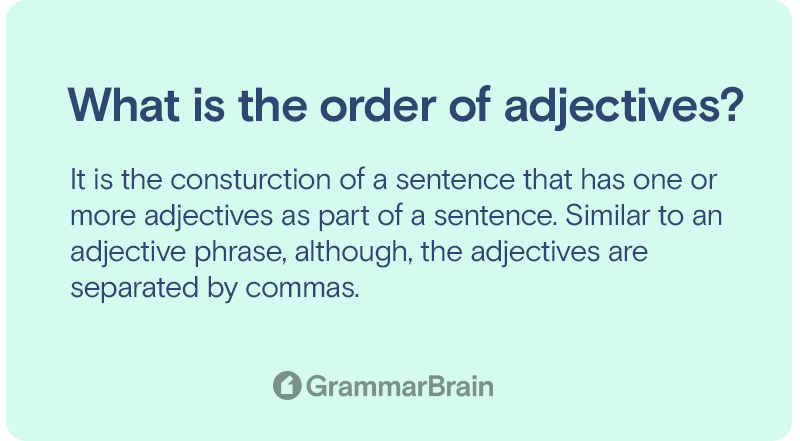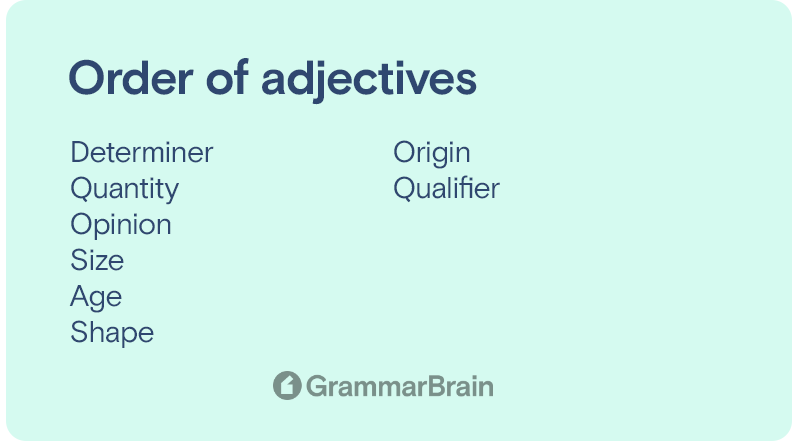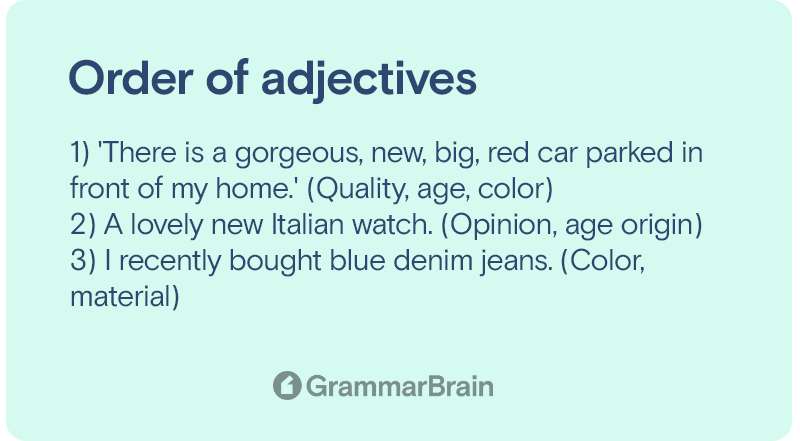What is the order of adjectives in English? Why are they important? How does it help us to form a complete sentence? Adjective order is a simple concept, it is a way of combining two or more adjectives in a single sentence. Native English speakers might do this naturally, without even knowing it.

What is the Adjective Order In English?
Think about the sentence – ‘My mother makes a French big meal every Sunday.’ It doesn’t sound right. Looking at this sentence technically – it provides you with all the information you need. There’s a big meal, the meal is French, your mother makes it, and she makes it every Sunday. So why does it sound wrong?
The order of adjectives is a particular order in which adjectives need to be placed and why the sentence above sounds wrong. The order of adjectives in the sentence isn’t correct. The correct sentence should be, ‘My mother makes a big French meal every Sunday.’
It’s common for students to learn what the adjective order are through reading books and listening to the English language. It’s not something that’s taught in schools. But it’s important nonetheless.

Why Is It Important?
The order of adjectives rules states that adjectives need to be placed in a particular order for the sentence to make sense (or to form a complete sentence). When it comes to the English language, the rules in place regarding adjectives’ order are more specific compared to many other languages.
This is why the sentence will sound’ right’ when you place adjectives in the correct order. When you deviate from that order, the sentence won’t sound ‘right’ anymore, even if the sentence is grammatically correct. In the English language, the order of adjectives is also called the Royal Order Of Adjectives. The following section details the adjective order rules and the correct order for placing adjectives.
Order of adjectives:
Determiner
A determiner isn’t a kind of adjective. It includes articles, demonstratives as well as possessives. The determiner will need to come both before the adjective and the noun that you’re trying to modify. Words considered determiners include ‘the,’ ‘these,’ ‘your,’ ‘our,’ and more.
Quantity
After you’ve placed your determiner, it’s time to add the quantity, if there is any. Here, you’ll be adding any relevant numbers to your sentence. Examples include every number, from ‘one’ to ‘a thousand’ and more. You can also use words like ‘few,’ ‘many,’ and ‘lots’ instead of numbers.
Opinion
This category is sometimes split into two separate categories. These include specific and general opinions, and both can be used in the same sentence. Let’s look at an example.
‘The book is popular, especially among self-care enthusiasts.’ In this case, the general opinion is that the book is popular. The specific opinion you add can be your personal opinion, and it may or may not be the popularly accepted opinion.
The general opinion, on the other hand, is widely accepted and can also be easily verified.
Size
If you want to add the size of an object, person or place to your sentence, then that comes next. The words you’ll be using in this category include words like ‘big’, ‘small’, ‘huge’, ‘tiny’, and more.
Age
After you’ve added the size, next comes age. Words such as ‘old’, ‘new’, ‘decades-old’, and more, fall in this category.
Shape
Then, you can add shapes, such as ‘circular’, ‘rectangular’, ‘square’, ‘triangular’ and more.
Color
Once the aforementioned adjectives have been added, you can add colors as well. Everything from ‘black’ to ‘white’, ‘red’ and green’, all fall in this category. You can also use words like ‘dark’ and ‘light’ to describe color.
Origin
In this category, you can add the origin of the subject, as well as what material it’s made out of. Examples of origin-related words include ‘American’, ‘French’, and more. You can also state what material the subject is made out of, such as ‘wood’ or ‘metal’.
Qualifier
Finally, after the other adjectives have been added to your sentence, you can add the Qualifier at the end. The qualifying adjective adds meaning to a noun. Take, for example, the words ‘vampire bat’. Here, ‘vampire’ is the qualifier that explains what kind of a bat is being talked about.
Another example of this is ‘the denim shirt.’ Here, ‘denim’ is the qualifier, and it explains what kind of shirt is being referred to.
Grammar Rules For The Order Of Adjectives
Now that you know what is adjective order, it’s time to look at the grammar rules for the order of adjectives. When you add adjectives to a sentence, it cannot be in just any order. This would ‘sound wrong’ to anyone fluent in the English language.
A particular order needs to be followed when adding adjectives to sentences. You probably already know this order, even if you haven’t studied it formally. Anytime you use more than one adjective to describe a noun, you’ll need to follow the order of adjectives. You also don’t need adjectives from every category in your sentence.
When constructing your sentence, you’ll need to add the determiner first, followed by other adjectives, such as those describing quality, size, color, and more.
Note that even though there’s a specific order to the adjectives you need to follow, sometimes you’ll need to change the adjective order for your sentence to make sense. Take, for example, the following sentence – ‘The tiny house that she moved into was brand-new.’
If you follow the order of adjectives, this sentence appears to be constructed wrong. Indeed, if the home she moved into were tiny, that would make sense. But when you’re talking about tiny homes, specific kinds of homes, the order of adjectives will change.

Examples of The Order of Adjectives
‘I adopted a beautiful small orange cat’ – here, ‘beautiful,’ ‘small,’ and ‘orange’ all describe what kind of a cat is being talked about. Since the adjectives are from different groups, you don’t need to add a comma between them.
Now let’s look at another example sentence –
‘Her home is blue and red.’ Here, since both ‘blue’ and ‘red’ are from the same category of adjectives, you’ll need to add the word ‘and’ between them.
You’ll need to add a comma between the adjectives if you construct a sentence with coordinate adjectives, say three or more. All except the last adjective, which should be preceded by the word ‘and,’ must be separated with commas. An example of a sentence that illustrates this is:
‘I gifted her a black, red and blue dress.’ Here, the first two colors mentioned are separated by a comma. Here are some more examples.
1) ‘There is a gorgeous, new, big, red car parked in front of my home.’ (Quality, age, color)
2) A lovely new Italian watch. (Opinion, age origin)
3) I recently bought blue denim jeans. (Color, material)
4) A great new French film. (Opinion, age, origin)
5) A large rectangular red box. (Size, shape, color)
Why Do Adjectives Need To Be In This Order?
It isn’t known why adjectives need to be in a particular order. Some theories are worth looking at, however. One of these theories is that the closer an adjective is placed to a noun, the it becomes more important to the description of that noun.
Take, for example, the words ‘fiberglass pool.’ The material ‘fiberglass’ helps describe what the pool is made out of. It’s also more descriptive than simply saying ‘large pool.’
However, this may not always apply. You could, for example, say, ‘white dog.’ Here, the color of the cat is described as black. But is it more descriptive than saying ‘large dog?’
Adjectives need to be in a particular order to give the sentence meaning and for the sentence to ‘sound right.’ However, there are exceptions as well.
How Adjectives Work With Commas
The rules of order of adjectives state that adjectives need to be placed in a particular order when you’re adding more than one adjective to your sentence. You should also note that sometimes, you’ll need to add commas between the adjectives, and at other times, you won’t need to.
But it’s not difficult to tell when you should add commas. Anytime you add adjectives from the same category to your sentence, you’ll need to separate the adjectives using commas. Let’s look at an example sentence.
Example sentence:
‘We live in a comfortable, expensive house.’
Since both ‘comfortable’ and ‘expensive’ belong to the same category of adjectives, you’ll need to add a comma between them. If you use more adjectives from the same category in your sentence, you’ll need to add commas between them.
But let’s say that you’re using adjectives from different categories. In this case, you won’t need to add a comma between the adjectives. Let’s look at an example.
Commas between different types of adjectives
‘He has a large blue swimming pool in his backyard.’ Here, ‘large’ belongs to the size category, and ‘blue’ belongs to the color category. Since the categories of the adjectives are different, you’ll need to add commas between them.
Also, note that you should never add a comma between the last adjective and the noun that it’s modifying. There should also never be a comma between the determiner of the noun and the adjectives describing that noun. By putting adjectives in the correct order, you’ll be able to create grammatically correct sentences.
Determiners are the words used at the start of the sentence, which provides information on what kind of noun, and how many of that noun, is being described. Take, for example, the sentence,’ That car is new.’ Here, ‘that’ is the determiner, showing that you’re talking about a specific car.
Commas with a determiners
Another example is ‘my school.’ Here, ‘my’ is the determiner, and it describes whose school it is. You can now add adjectives to that sentence. ‘My large, progressive new school.’ Here, you’re providing more information about the school.
You may still find it confusing to know whether you should add commas to your sentence. But there’s a helpful trick that can help you decide.
Anytime you find that you can add ‘and’ between your adjectives and can also change the order of the adjectives without making the sentence confusing, you don’t need to add commas.
The sentence ‘My large, progressive and new school’, can also be written as ‘my new, progressive, and large school.’ By using the word ‘and,’ you eliminate the need to add a comma.
How Sentence Position Affects Adjective Order
You should by now know what the order of adjectives meaning is. But what relationship does the sentence position have to the adjective order? Usually, adjectives go before the noun that’s being modified. Let’s look at an example sentence – ‘The market was noisy and crowded.’ In this sentence, the adjective comes after the verb, which comes from ‘to be.’ You can also efficiently rewrite this sentence.
In the sentence ‘It was a noisy, crowded market,’ the adjectives are placed before the noun. When adjectives are placed before a verb, you don’t need to follow the comma rules. But when they precede a noun, commas will need to be used.
At the same time, should the last word of the sentence be an adjective, then it needs to be preceded by ‘and’
‘Her cat was small and orange.’ Here, both ‘small’ and ‘orange’ are adjectives. Since ‘orange’ is the last word of the sentence and also an adjective, it’s preceded by the word ‘and.’ But what if you need to add more than two adjectives to a sentence?
Unless you use the Oxford comma, all the adjectives, except the last one, will need to be separated by commas.
‘Their home is modern, spacious, and drafty.’ Here, ‘modern,’ ‘spacious,’ and ‘drafty’ are all adjectives. The first two adjectives are separated using a comma.
FAQs
What is the Order of Adjectives?
If you’re wondering what is the order of adjectives, the answer is that adjectives need to be placed in a specific order when constructing sentences. The determiner comes first, followed by the other qualities that modify the noun. A particular order needs to be followed for the sentence to ‘sound right.’
When Should You Add Commas Between Adjectives?
Anytime the adjectives you’re using are from the same category, you’ll need to add commas to separate the adjectives.
What is the Correct Order of Adjectives?
The correct order of adjectives is as follows. The determiner comes first, followed by a quantity, then opinion and size. Next is physical quality, shape, and age. This is followed by color, origin, and material. Type and purpose come last.
How common is it to see more than three adjectives in a sentence?
It’s very uncommon. It is more common to see adjective phrases.
Should a comma get placed between three or more adjectives?
Yes. This follows the Oxford comma rule (or serial comma rule). Separate each adjective with a comma. The same applies for two or more adjectives in a single sentence.
What are opinion adjectives?
They are adjectives that are about size, shape, age, color, origin, and material purpose. These descriptive adjectives help provide thought and idea.
Inside this article
Fact checked:
Content is rigorously reviewed by a team of qualified and experienced fact checkers. Fact checkers review articles for factual accuracy, relevance, and timeliness. Learn more.
Core lessons
Glossary
- Abstract Noun
- Accusative Case
- Anecdote
- Antonym
- Active Sentence
- Adverb
- Adjective
- Allegory
- Alliteration
- Adjective Clause
- Adjective Phrase
- Ampersand
- Anastrophe
- Adverbial Clause
- Appositive Phrase
- Clause
- Compound Adjective
- Complex Sentence
- Compound Words
- Compound Predicate
- Common Noun
- Comparative Adjective
- Comparative and Superlative
- Compound Noun
- Compound Subject
- Compound Sentence
- Copular Verb
- Collective Noun
- Colloquialism
- Conciseness
- Consonance
- Conditional
- Concrete Noun
- Conjunction
- Conjugation
- Conditional Sentence
- Comma Splice
- Correlative Conjunction
- Coordinating Conjunction
- Coordinate Adjective
- Cumulative Adjective
- Dative Case
- Determiner
- Declarative Sentence
- Declarative Statement
- Direct Object Pronoun
- Direct Object
- Diction
- Diphthong
- Dangling Modifier
- Demonstrative Pronoun
- Demonstrative Adjective
- Direct Characterization
- Definite Article
- Doublespeak
- False Dilemma Fallacy
- Future Perfect Progressive
- Future Simple
- Future Perfect Continuous
- Future Perfect
- First Conditional
- Irregular Adjective
- Irregular Verb
- Imperative Sentence
- Indefinite Article
- Intransitive Verb
- Introductory Phrase
- Indefinite Pronoun
- Indirect Characterization
- Interrogative Sentence
- Intensive Pronoun
- Inanimate Object
- Indefinite Tense
- Infinitive Phrase
- Interjection
- Intensifier
- Infinitive
- Indicative Mood
- Participle
- Parallelism
- Prepositional Phrase
- Past Simple Tense
- Past Continuous Tense
- Past Perfect Tense
- Past Progressive Tense
- Present Simple Tense
- Present Perfect Tense
- Personal Pronoun
- Personification
- Persuasive Writing
- Parallel Structure
- Phrasal Verb
- Predicate Adjective
- Predicate Nominative
- Phonetic Language
- Plural Noun
- Punctuation
- Punctuation Marks
- Preposition
- Preposition of Place
- Parts of Speech
- Possessive Adjective
- Possessive Determiner
- Possessive Case
- Possessive Noun
- Proper Adjective
- Proper Noun
- Present Participle
- Prefix
- Predicate



